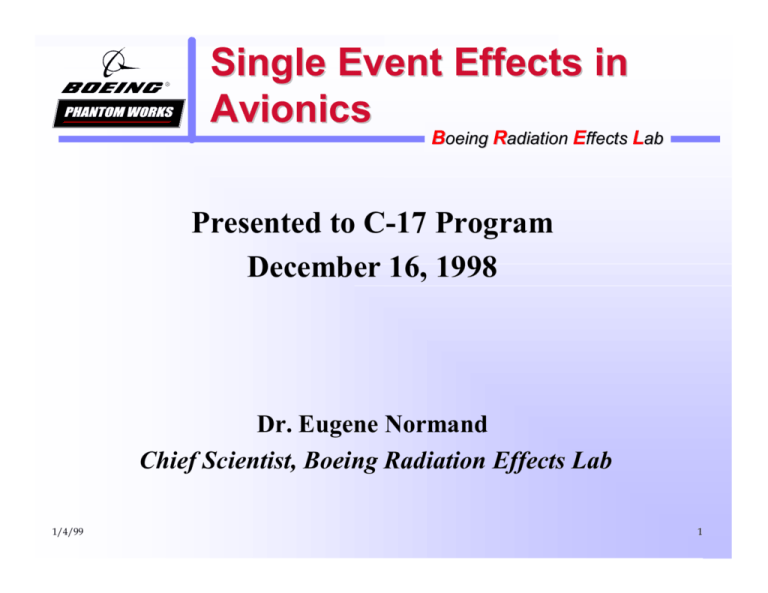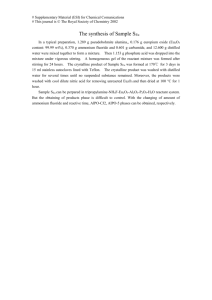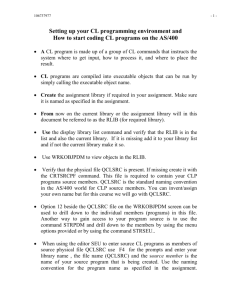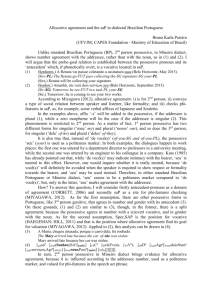Single Event Upsets in Avionics
advertisement

Single Event Effects in Avionics Boeing Radiation Effects Lab Presented to C-17 Program December 16, 1998 Dr. Eugene Normand Chief Scientist, Boeing Radiation Effects Lab 1/4/99 1 Overview of Presentation Boeing Radiation Effects Lab n n n n n 1/4/99 Introduction to Single Event Effects [SEE] Atmospheric Neutron Environment Evidence for Neutron-Induced SEU in Avionics Environments and Effects Related to Avionics SEU Results of Recent Avionics SEU Evaluation 2 Description of Various Types of Single Event Effects in ICs Boeing Radiation Effects Lab n Single Event Effects [SEE] ä Disturbance of an active electronic device caused by a single energetic particle l l l l 1/4/99 Upset (SEU) --change in logic state, simplest example is a memory cell in RAM Latchup (SEL) --sharp increase in current resulting from turning on parasitic pnpn Damage or burnout (SEB) of power transistor or other high voltage device Functional interrupt (SEFI)- malfunctions in more complex parts sometimes as lockup, hard error, etc 3 SEE: Which Environments are Important Boeing Radiation Effects Lab n Space ä ä ä n Aircraft Altitudes ä n Neutrons and Protons (Pions) Ground Level ä 1/4/99 Galactic Cosmic Rays (heavy ions) Trapped Belts (protons) Solar Flares (protons & heavy ions) Neutrons and Protons 4 Neutron Environment in the Atmosphere Boeing Radiation Effects Lab Neutrons, created by cosmic ray interactions with the O2 and N2 in the air, peak at ~60,000 ft. At 30,000 ft the neutrons are about 1/3 the peak flux, and on the ground, ~1/400 of the peak flux. The peak flux is ~4 neutron/cm²sec. Other particles such as secondary protons and pions are also created, but for SEU the neutrons are the most important. 1/4/99 5 1-10 MeV Atmospheric Neutron Flux vs. Altitude, Simplified Boeing Model 1.4 1.6 1.2 1.4 1.2 1 1 0.8 0.8 0.6 0.6 0.4 0.4 0.2 Normalized Flux 1-10 MeV Neut Flux, n/cm^2sec Boeing Radiation Effects Lab 0.2 0 0 0 5 10 15 20 25 30 35 40 45 50 55 60 65 70 75 80 Altitude, Thousands of Feet 1/4/99 6 1-10 MeV Atmospheric Neutron Flux vs. Latitude, Simplified Boeing Model Boeing Radiation Effects Lab 1-10 MeV Neut Flux, n/cm²sec 1.8 1.6 1.4 1.2 1 0.8 0.6 0.4 0.2 0 0 10 20 30 40 50 60 70 80 90 Latitude, degrees 1/4/99 7 Energy Dependence of Atmospheric Neutron Flux, Simplified Boeing Model Boeing Radiation Effects Lab 1E+0 Boeing Model, Fit to Ms'rd NASA-Ames Data Armstrong Calculation Diff'tial Neutron Flux, n/cm²-s-MeV 1E-1 1E-2 1E-3 1E-4 1E-5 1E+0 1/4/99 1E+1 1E+2 Neutron Energy, MeV 1E+3 1E+4 8 4 Independent Sources Confirm Atmospheric Neutrons as Cause of Avionics SEU Boeing Radiation Effects Lab Basis of Neutrons as Cause 1/4/99 Airborne Data Serving as Basis 1. Variation of in-flight SEU rates with altitude and latitude have the same behavior as the variation of atmospheric neutron flux with altitude and latitude 1. In-flight SEU rates from IBM experiments (over, Seattle, northern California and Norway) and from CC-2E computer in TS-3 E-3 aircraft (mainly over West Coast) 2. Agreement between the measured in-flight upset rates and the upset rates calculated using the atmospheric neutron flux and laboratory-measured SEU cross section data 2. In-flight SEU rates from IBM experiments (over Seattle, northern California and Norway), CC-2E computer on TS-3 (West Coast), CC-2E computer on military aircraft in Europe and SRAMs in other aircraft (transAtlantic and worldwide) 9 4 Independent Sources Confirm Atmospheric Neutrons as Cause of Avionics SEU, Cont’d Boeing Radiation Effects Lab Basis of Neutrons as Cause 1/4/99 Airborne Data Serving as Basis 3.Agreement between ground level SEU rates in SRAMs and DRAMs and those at aircraft altitudes, when accounting for the difference in atmospheric neutron flux at ground and 4E4 Ft. 3. In-flight SEU rates in 1 and 2 above and measured ground level rates at various locations in US (Seattle, Austin, TX and Batavia, IL) 4. Agreement between the energy deposition spectrum measured in the airborne CREAM detector and the spectrum measured in Boeing's surface barrier detector in the WNR high energy neutron beam at Los Alamos 4. Energy deposition spectra in the CREAM detector onboard Concorde on LondonWashington, D.C., London-New York and Washington-Miami routes 10 Correlation of SEU Rate and Atmos. Neutron Flux with Altitude Boeing Radiation Effects Lab 1-10 MeV Neutron Flux and SEU Rate 1.E+01 Memory Upset Rate 1.E+00 Neutron Flux at Altitude 1.E-01 1-10 MeV Atm Neutron Flux SEU Rate, Up/bit-day ×1E7 1.E-02 0 1/4/99 10000 20000 30000 40000 Altitude, Ft 50000 60000 70000 80000 11 Correlation of SEU Rate and Atmos. Neutron Flux with Latitude Boeing Radiation Effects Lab SEU/Hr and n/cm²-sec 4E-2 3E-2 2E-2 In-Flight SEUs, Europe & N. America 1E-2 1-10 MeV Boeing Atmos Neut Flux (× .02) 0E+0 30 1/4/99 40 50 60 Latitude, Degrees 70 80 90 12 Comparison of Measured and Calculated In-flight SEU Rates Boeing Radiation Effects Lab Aircraft Flight Path E-3 Seattle Altitude, System ft (×E3) 29 IBM Exp’t ER-2 N. Cal. 65 IBM Exp’t ER-2 Norway. 65 IBM Exp’t E-3 Europe-1 29 CC-2E E-3 Europe-2 29 CC-2E Com’cll Trans~35 PERF. Jetliner Altlantic computer F-4 S. Calif. <25 AP-102 Com’cl WorldJetliner wide 1/4/99 ~33 Calct’d Operat’g SRAM # Meas’d Condt’ns Upset Up/bit-hr Up/bit-hr 4.4-8 E-9 2.5 V IMS 64K 10 5E-9 2.5 V IMS 64K 12 1.1E-8 1-2 E-8 2.5 V EDI 256K IMS 64K IMS 64K EDI 256K IMS 64K 6 4.6E-9 8-14 E-9 53 83 14 2.3 E-9 1.6E-9 4.8E-8 1.8-4.7E-9 1.3-2.7E-9 2.3E-8 4 5.4E-8 3.4E-10 IDT 256K ----- 3.3E-10 5E-10 5V 5V 5V5V Avionics 5 V computer 13 Comparison of SEU Rates on Ground, Field Data and WNR Rates Boeing Radiation Effects Lab Observed Rate From Field RAM System/SER Source of Data hr DRAMACPMAPS Computer Fermilab7E-13 IBM Field Tests 3E-13 “ CRAY YMP-8, Bulk Storage 6E-13 “ Nite Hawk 5800 Computer 2E-12 “ DRAM Simple Average 1E-12 SRAM Motorola Field SER tests 2E-12 ICDs within patients 2E-12 “ CRAY YMP-8 Main Memory 2E-12 “ “ SRAM Simple Average Upset Rate From WNR Similar RAM at WNR Up/b-hr TC514400-80 2E-12 MSM514400-80 4E-13 TMS44100 2E-12 Simple Average IDT71256 HM65656 MCM6206 MCM6246 2E-12 Simple Average (4) 2E-12 1E-12 4E-12 3E-12 2E-13 2E-12 Conclude that field Upset rates (large computers, RAM vendor tests, etc.) agree with upset rates based on measured SEU rates in WNR neutron beam combined with measured cosmic ray neutron flux at ground level 1/4/99 14 Comparison of Ground-Level SEU Rates with Rates in Aircraft Boeing Radiation Effects Lab Measr'd Vendor/ WNR SEU RAM Type X-Sct'n, RAM (D or S) cm²/bit TC514400 Toshiba/D 1.2E-13 MSM514400 Oki/D 2.2E-14 TMS44100 TI/D 9.3E-14 IDT71256 IDT/S 6.5E-14 HM65656 Matra/S 1.9E-13 MCM6206 Motorola/S 1.4E-13 MCM6246 Motorola/S 1.3E-14 Average (7 RAMs) 1.9E-13 Gr'nd level SEU Rate, Up/bit-hr, WNRScaled 2.3E-12 4.3E-13 1.8E-12 1.3E-12 3.7E-12 2.7E-12 2.4E-13 1.8E-12 Calculated Ground SEU Rate, Up/bithr, BGR Method 2.1E-12* N/A 2.3E-12 2.3E-12 1.2E-12 7E-13* 3.4E-13 2.5E-12 * Indicates Heavy ion SEU data from related RAM Ground level SEU rate ~2E-12 Upset/bit-hr Aircraft SEU rate (neutron flux ~300 times higher) is 300×2E-12, ~6E-10 Upset/bit-hr, agrees w/ in-flight SEU rates 1/4/99 15 Correlation of Energy Deposition Spectra, CREAM on Concorde and SBD in WNR Beam Boeing Radiation Effects Lab BGR (cm²/µm³) 1E-12 1E-13 WNR, 300 µm S BD 1E-14 WNR, 10 µm SBD CREAM onboard Conc o rde 1E-15 1E-16 1E-17 1E-18 1E-19 1 10 100 1000 Energy Deposited (MeV) 1/4/99 16 BREL Approach for Dealing with SEE in Avionics Boeing Radiation Effects Lab n Testing ä ä n Analysis ä ä 1/4/99 WNR (at LANL) same neutron spectrum as atmospheric neutrons 14 MeV generator (BREL) BGR method can utilize heavy ion data to estimate neutron-induced SEU response New BGR-based model to explain neutron-induced latchup (SEL) 17 Use of the WNR Beam Boeing Radiation Effects Lab n n 1/4/99 BREL has used WNR beam (LANL) to measure SEU in RAMs, µprocessors, SEL in gate arrays and SEB in power MOSFETs and high voltage diodes This means that these SEEs can be induced by neutrons in aircraft and on ground WNRNeutron Fluxes 1E+9 WNR flux, 30L WNR flux, 60R Atmos Flux × 3E5 1E+8 1E+7 1E+6 1E+5 1 10 100 Neutron Energy, MeV 1000 18 Results of Recent SEE Evaluation of Avionics System Boeing Radiation Effects Lab n Based on new mission computing and communications subsystems, total of ~20-30 SBCs ä ä ä SEU in main memory well protected by EDAC SEU in cache memory (protected by parity checking) will result in “reconfiguration” ~once every 2-3 hours SEU in unprotected devices results in reboot once every ~100-200 hours (cumulative, all devices) l ä Still large uncertainties in response of some devices that can only be reduced by SEU testing l 1/4/99 Includes microprocessors, FPGAs, MBU in main memory Microprocessor response based only on PowerPC 603 that was tested with protons for space applications 19 Perceived Current Status of SEE in C-17 Avionics Systems Boeing Radiation Effects Lab n Flight Controls ä n Appears to be adequately protected through combination of EDAC and redundancy Mission Avionics ä ä ä More likely to have subsystems that may not be adequately protected Anecdotal story (from Wright-Patt, ~4 years ago) of upsets in computer during flight, fixed via EDAC Could check operational logs for evidence of malfunctions during flight that could not be detected when box tested in the lab (Could Not Duplicate, Retest OK) l 1/4/99 In commercial avionics experience, ≈20% of all CNDs are due to SEUs 20 How Can BREL Help? Boeing Radiation Effects Lab n n n n n 1/4/99 Provide environmental requirements section (atmospheric neutrons) to be incorporated into specs for future upgrades Assist in carrying out SEU evaluations/reviews of future avionics upgrades Carry out SEU evaluations of existing systems in which SEU problems most likely, e.g. new flat panel display Identify current systems containing EDAC protection from which direct evidence of SEU occurrences may be derived from operational logs Incorporate error logging features into EDAC protection to allow SEU occurrences to be monitored, thereby providing feedback for design of future systems 21







